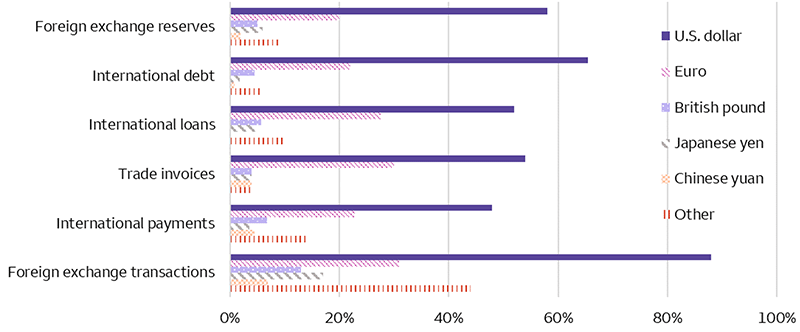July 8, 2025
Jennifer Timmerman Investment Strategy Analyst
U.S. dollar dominance in perspective
 Sources: Wells Fargo Investment Institute, Brookings Institute, Atlantic Council (Dollar Dominance Monitor), Bank for International Settlements (Triennial Central Bank Survey), European Central Bank (The International Role of the Euro Report), International Monetary Fund (Currency Composition of Official Foreign Exchange Reserves), Society for Worldwide Interbank Financial Telecommunication (RMB [renminbi] Tracker). Note: China is included in “Other” for the international loans category. Trade invoice and international payments data excludes Eurozone trade. Sum of shares of foreign exchange transactions totals 200% since each transaction involves two currencies. Data as of June 30, 2025, latest available for each metric. Excerpted from Investment Strategy report (July 7)
Sources: Wells Fargo Investment Institute, Brookings Institute, Atlantic Council (Dollar Dominance Monitor), Bank for International Settlements (Triennial Central Bank Survey), European Central Bank (The International Role of the Euro Report), International Monetary Fund (Currency Composition of Official Foreign Exchange Reserves), Society for Worldwide Interbank Financial Telecommunication (RMB [renminbi] Tracker). Note: China is included in “Other” for the international loans category. Trade invoice and international payments data excludes Eurozone trade. Sum of shares of foreign exchange transactions totals 200% since each transaction involves two currencies. Data as of June 30, 2025, latest available for each metric. Excerpted from Investment Strategy report (July 7)U.S. dollar has been undergoing a challenging repricing period this year amid rapid policy change
U.S. tariff and budget uncertainty have whipsawed both equity and fixed-income markets this year, but perhaps the most worrisome asset move for many investors has been the U.S. dollar’s noticeable selloff. The U.S. Dollar Index has dropped more than 10% year to date through June 30, 2025, sparking worries about the dollar’s potential demise.
As shown in the chart, however, the U.S. dollar accounts for an overwhelming majority of the currency share for various measures of global foreign trade and investment. Taking this statistical approach to analyzing the U.S. dollar’s role, it is clear to us that the greenback remains the linchpin of global trade and finance and is far from becoming irrelevant.
What it may mean for investors
We prefer to avoid making portfolio adjustments on speculation that the dollar may be in danger of losing its global status soon. Over the longer term, there is a risk of the slow erosion seen in recent years persisting. For now, however, we believe the U.S. dollar benefits from deep-seated advantages that make a global shift away from it a difficult, slow-moving process. For further detail, please see our Special Report, “The dollar’s future as an international currency.”
Risk Considerations
Each asset class has its own risk and return characteristics. The level of risk associated with a particular investment or asset class generally correlates with the level of return the investment or asset class might achieve. Stock markets, especially foreign markets, are volatile. Stock values may fluctuate in response to general economic and market conditions, the prospects of individual companies, and industry sectors. Foreign investing has additional risks including those associated with currency fluctuation, political and economic instability, and different accounting standards. These risks are heightened in emerging markets. Bonds are subject to market, interest rate, price, credit/default, liquidity, inflation and other risks. Prices tend to be inversely affected by changes in interest rates.
Currency risk is the risk that foreign currencies will decline in value relative to that of the U.S. dollar. Exchange rate movement between the U.S. dollar and foreign currencies may cause the value of a portfolio's investments to decline.
Definitions
The United States Dollar Index or DXY measures the performance of the dollar against a basket of other currencies including EUR, JPY, GBP, CAD, CHF and SEK.
An index is unmanaged and not available for direct investment.
General Disclosures
Global Investment Strategy (GIS) is a division of Wells Fargo Investment Institute, Inc. (WFII). WFII is a registered investment adviser and wholly owned subsidiary of Wells Fargo Bank, N.A., a bank affiliate of Wells Fargo & Company.
The information in this report was prepared by Global Investment Strategy. Opinions represent GIS’ opinion as of the date of this report and are for general information purposes only and are not intended to predict or guarantee the future performance of any individual security, market sector or the markets generally. GIS does not undertake to advise you of any change in its opinions or the information contained in this report. Wells Fargo & Company affiliates may issue reports or have opinions that are inconsistent with, and reach different conclusions from, this report.
The information contained herein constitutes general information and is not directed to, designed for, or individually tailored to, any particular investor or potential investor. This report is not intended to be a client-specific suitability or best interest analysis or recommendation, an offer to participate in any investment, or a recommendation to buy, hold or sell securities. Do not use this report as the sole basis for investment decisions. Do not select an asset class or investment product based on performance alone. Consider all relevant information, including your existing portfolio, investment objectives, risk tolerance, liquidity needs and investment time horizon. The material contained herein has been prepared from sources and data we believe to be reliable but we make no guarantee to its accuracy or completeness.
Wells Fargo Advisors is registered with the U.S. Securities and Exchange Commission and the Financial Industry Regulatory Authority, but is not licensed or registered with any financial services regulatory authority outside of the U.S. Non-U.S. residents who maintain U.S.-based financial services account(s) with Wells Fargo Advisors may not be afforded certain protections conferred by legislation and regulations in their country of residence in respect of any investments, investment transactions or communications made with Wells Fargo Advisors.
Wells Fargo Advisors is a trade name used by Wells Fargo Clearing Services, LLC and Wells Fargo Advisors Financial Network, LLC, Members SIPC, separate registered broker-dealers and non-bank affiliates of Wells Fargo & Company.


